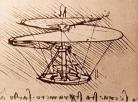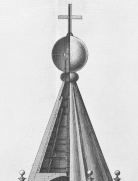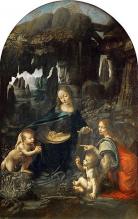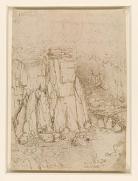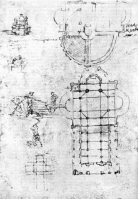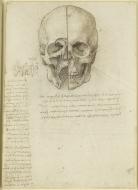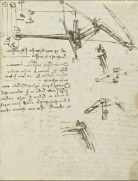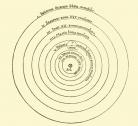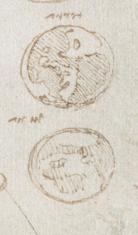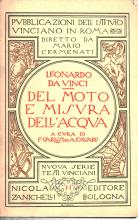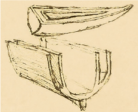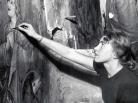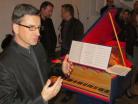da Vinci and the Renaissance 2020 Timeline
Created by Dino Franco Felluga on Wed, 01/15/2020 - 17:50
Part of Group:
This timeline will support a Purdue's Honors College course, da Vinci and the Renaissance, along with a connected study-abroad program to Venice and Florence over March Break 2020.
Timeline
Chronological table
| Date | Event | Created by | Associated Places | |
|---|---|---|---|---|
| 6 Jan 29 |
Baptism of ChristJesus Christ was baptized in the year 29 on the river Jordan. He was baptized by his cousin, John the Baptist. Of course, this is all religious history, much of which is according to the Catholic Bible. Jesus' baptism, upon first glance, seemed pointless—after all, if the point of a baptism is to cleanse a person from sin, and if Jesus Christ didn't sin, why would he need to go through all the trouble of baptism? However, Jesus Christ insisted that it was necessary to be baptized to "fulfill all righteousness". Additionally, it displayed that Jesus Christ, although he was born without sin, was able to humble himself and set an example, by appearing as another human being. Although there is no concrete proof of a specific date as to when Jesus Christ was baptized, it is typically celebrated on January 6th. This day is known as the Epiphany, and is celebrated as the day when God was incarnated as Jesus Christ. Two important events occurred in Jesus Christ's time on Earth on this date: first, this is considered the day of the Three Kings, in which Jesus Christ was visited by Three Kings shortly after his birth, and he was gifted gold, frankincense, and myrrh. Additionally, several years later, this date is celebrated as Jesus Christ's Baptism, so the Epiphany is an important day in Christian history. Work Cited: “BibleGateway.” Matthew 3:13-17 NIV - - Bible Gateway, www.biblegateway.com/passage/?search=Matthew+3:13-17&version=NIV. GotQuestions.org. “Home.” GotQuestions.org, 7 Feb. 2011, www.gotquestions.org/Jesus-baptized.html. |
Arija Simonaitis | ||
| 1403 |
Rise of Renaissance ArchitectureIn the early 15th century, the beginnings of the Renaissance were taking shape. One of those areas was architecture. Filippo Brunelleschi, an Italian architect, visited Rome and analyzed buildings that were built centuries ago. The rise of classicism brought back aspects of Greek and Roman architecture like symmetry and geometry and were used in projects like the interior of the Church of San Lorenzo and the Florence Cathedral. Brunelleschi is credited as the founder of Renaissance architecture and influenced future architects like Leonardo da Vinci, who used a series of squares and rectangles in his drawings, much of them included a huge dome in the center after Brunelleschi's revolutionary design. Sources: Ackerman, James S. “Architectural Practice in the Italian Renaissance.” Journal of the Society of Architectural Historians, vol. 13, no. 3, 1954, pp. 3–11. JSTOR, www.jstor.org/stable/987700. Burckhardt, Jacob, et al. The Architecture of the Italian Renaissance. University of Chicago Press, 1987. Craven, Jackie. “The Significance of Renaissance Architecture.” ThoughtCo, ThoughtCo, 6 Nov. 2019, www.thoughtco.com/renaissance-architecture-and-its-influence-178200. Image: https://www.florenceinferno.com/the-brunelleschi-dome/ |
Adam Sands | ||
| 1414 |
Poggio Bracciolini's Collection of Classical ManuscriptsDuring the Middle Ages, Vitruvius’s de Architectura was forgotten and only rediscovered in 1414. Leonardo da Vinci’s predecessor and early Renaissance humanist, Poggio Bracciolini had included it in his collection of classical writing when he discovered it the Library at Abbey of Saint Gall in St. Gallens, Switzerland. The rest of his collection, which was curated from libraries all over Western Europe, include Astronomica, detailing astronomical phenomena, by Manilius, De Aquaeductu, or On Aqueducts, by Frontinus, and De Rerum Natura, or On the Nature of Things, by Lucretius. This collection of classical writing largely influenced Renaissance thinking. Apart from de Architectura, the poem, On the Nature of Things, led to Renaissance philosophy and the knowledge-seeking ideal. The poem describes a multitude of phenomena, including that everything in the world is comprised of small particles, which we know of as atoms now. Source: Isaacson, Walter. “Chapter 8 Vitruvian Man.” Leonardo Da Vinci: The Biography, Simon & Schuster, 2018. |
Kanti Bharat | ||
| circa. 1467 to circa. 1472 |
Leonardo Works on Theatrical Productions During ApprenticeshipDuring his years as an apprentice in Florence, Leonardo spent much time working on creating pageants and theatrical performances for the Medici family. This work included creating costumes and scenery and devising new designs for stage machinery and special effects. Among the special effects used in these pageants were devises that allowed performers and props to be suspended through the air. Many scholars suggest that a number of Leonardo’s devices for human flight were actually created for or inspired by stage mechanisms for theatrical purposes. Many believe that the famous helicopter, or aerial screw, was actually a originally designed as a ingegni, or devise for changing scenery. During his early work in theater, Leonardo learned much about engineering, design principles, and creativity that he would continually apply to his other works. Source Isaacson, Walter. Leonardo Da Vinci: the Biography. Simon & Schuster, 2018. |
Elise Zaniker | ||
| 10 Sep 1468 |
Verrocchio's CommissionIn 1468 it was decided that the appropriate decoration for the lantern Fillippo Brunelleschi had created around 30 years prior was to be a bronze ball (palla) and cross. A competition was created to determine which artist would be given the honor of creating the palla that was to adorn the top of the Florence Duomo. While Andrea del Verrocchio was not the winner of the competition, he received the commission to make the palla after the first attempt by another artist was unsatisfactory. September 10, 1468 marked the day that Verrocchio began his project, along with his colleagues which included a teenage Leonardo da Vinci. Works Cited: Bambach, Carmen. Leonardo Da Vinci Master Draftsman: Catalogue to an Exhibition at The Metropolitan Museum of Art, New York 2003. Yale University Press, 2003. Neilson, Christina. Practice and Theory in the Italian Renaissance Workshop: Verrocchio and the Epistemology of Making Art. Cambridge University Press, 2019. |
Ariana Eskew | ||
| 1470 |
"The Baptism of Christ"The Baptism of Christ is a famous work of art by Leonardo Da Vinci with his instructor, Andrea del Verrocchio. This piece was originally intended for the monks of San Salvi, a Catholic monastery in eastern Florence. Verrocchio's brother was an abbot here, meaning he was the head of the monks at San Salvi. The Baptism of Christ painting was a commission and was used as an altarpiece. The painting was kept in this location from approximately the 1470's until 1530, after the monastery was destroyed. The painting was moved to Santa Verdiana, another monastery, and in 1919, was rediscovered and moved to the Uffizi gallery, where it has remained ever since. Works Cited: “The Baptism of Christ.” The Baptism of Christ by Verrocchio and Leonardo Da Vinci, www.leonardo-da-vinci.net/baptism-of-christ/. “Verrocchio.” Cavallini to Veronese - Italian Renaissance Art, cavallinitoveronese.co.uk/general/view_artist/45. |
Arija Simonaitis | ||
| circa. 1482 |
Leonardo Da Vinci Plans the Largest Equestrian StatueIn 1482, Leonardo Da Vinci was asked to create the largest equestrian statue in the world by Ludovico Sforza who would later be the Duke of Milan (National Geographic). By studying real horses, Leonardo created plans and a clay model around 1493. He planned to be able to cast the horse in only one process by putting molds between two ovens and filling them to cast the entire statue. In 1499, though, Milan was in war with France during the Second Italian War (also known as the Italian War of Louis XIII) and French troops invaded the city (History of War). The bronze that was going to be used for the horse statue was instead used for weapons for Milan; when Milan was eventually defeated by France, French archers destroyed the clay model (Da Vinci Science Center). With the model ruined and his supplies repurposed, Leonardo Da Vinci never tried to construct the horse again. Collector/Album, Photograph by Print. “Why Leonardo's Last Statue Took 500 Years to Finish.” Leonardo's Horse Took 500 Years to Make, 30 Apr. 2019, www.nationalgeographic.com/history/magazine/2019/05-06/after-death-da-vi.... Rickard, J. “Second Italian War/ Italian War of Louis XII (1499-1503).” Second Italian War/ Italian War of Louis XII (1499-1503), 22 Aug. 2014, www.historyofwar.org/articles/wars_second_italian_war.html. “The Full Story of Leonardo's Horse.” Da Vinci Science Center, www.davincisciencecenter.org/about/mission-and-history/leonardo-and-the-.... |
Lauren Lum | ||
| 1483 to 1484 |
The Virgin of the Rocks PaintingsIn 1483, the painting The Virgin of the Rocks was comissioned by the San Francesco Grande in Milan by a roup of religious followers devted to the Immaculate Conception. This group commissioned this painting to be on wooden panel so that it could eventually be placed inside of a larger piece of artwork on the altar of this church. A few years after this painting was created, Leonardo created a second version which was restored around 2010 and is in the National Gallery in London whereas the original is unrestored in the Louvre. The two paintings actually have several differences between the two of them inluding coloring differences, a halo over one of the Virgin Marys and not the other, and a couple of others. Works Cited: By Leonardo da Vinci - gallerix.ru, Public Domain, https://commons.wikimedia.org/w/index.php?curid=32430178 “Leonardo Da Vinci's Virgin of the Rocks.” ItalianRenaissance.org, www.italianrenaissance.org/leonardo-da-vincis-virgin-of-the-rocks/. “The Virgin of the Rocks.” Italian Renaissance Art.com, www.italian-renaissance-art.com/Virgin-of-the-Rocks.html. “Leonardo Da Vinci: The Virgin of the Rocks: NG1093: National Gallery, London.” The National Gallery, www.nationalgallery.org.uk/paintings/leonardo-da-vinci-the-virgin-of-the.... |
Madeline Quinn | ||
| 1483 to 1484 |
Geological SketchesThis sketch is suspected to be created around 1483 and it's believed that this ravine wasn't an actual place, but instead from Leonardo da Vinci's imagination. The only way for Leonardo to have been able to create a realistic looking ravine without copying one he would have been looking at would be to study them extensively. This has also been proven by some of his ideas about the actual age of the Earth. Although exceedingly controverisal, Leonardo believed the earth was much older than thought at the time because he studied different seashells found on mountain tops and theorized that they couldn't have been placed there. Instead, water was one there and as time passed, the water levels decreased and fossils of bones were left in areas of higher elevation. Leonardo also understood that this process wouldn't happen quickly, but slowly over long periods of time. Although there doesn't appear to be any shells in this image, the decrease in water level is clearly visible in this sketch. Works Cited: Jones, Johnathan. Leonardo Da Vinci's Earth-Shattering Insights about Geology. 23 Nov. 2011, www.theguardian.com/artanddesign/jonathanjonesblog/2011/nov/23/leonardo-.... Leonardo da Vinci [CC BY-SA (https://creativecommons.org/licenses/by-sa/4.0)] “Leonardo Da Vinci (Vinci 1452-Amboise 1519) - A Ravine.” Royal Collection Trust, www.rct.uk/collection/912395/a-ravine. Rosenberg, Gary D. The Revolution in Geology from the Renaissance to the Enlightenment. |
Madeline Quinn | ||
| circa. 1483 |
Self-Supporting Bridge designsIn 1482, DaVinci wrote to Duke Sforza to be a military engineer for his army in the fight against France. DaVinci got the job and worked in Milan for the next 17 years as a military engineer. During his first few years working in Milan, Leonardo designed many bridges and structures, including the self-supporting bridge. This bridge could be built in minutes and be built without fasteners or joints. It is a bridge made of beams that crisscross each other like scissors and use the pressure to hold each other stable; the greater the pressure the greater the stability. It was often used by the Milanese military at the time for its ease of use and it has been used in many parades and events as a short-term, safe bridge. “Leonardo Da Vinci: Self-Supporting-Bridge.” Leonardo3, Leonardo Museum, www.leonardo3.net/en/l3-works/machines/1355-self-supporting-bridge.html. Sniderman, Debbie. “Leonardo Da Vinci.” ASME, The American Society of Mechanical Engineers, 10 Apr. 2012, www.asme.org/topics-resources/content/leonardo-da-vinci. Noe, Rain. “Leonardo Da Vinci's Ingenious Design for a Self-Supporting Bridge.” Core77, 6 Apr. 2017, www.core77.com/posts/65043/Leonardo-da-Vincis-Ingenious-Design-for-a-Sel.... |
Blake Hakimian | ||
| circa. 1487 |
Leonardo da Vinci Draws the Vitruvian ManThe Vitruvian Man embodies the Renaissance ideals of geometry, architecture, humanism, etc and Leonardo da Vinci’s nature as a polymath. It has been observed that da Vinci detailed his drawing to an unnecessary extent for solely displaying scientific information. It can be assumed then, that da Vinci wishes to comment on the beauty of the human body as well as its perfection in geometric form. Some have also observed that there is an illusory effect that the figure in the drawing is in motion, as da Vinci portrays “one leg and then the other being pushed out and pulled back, the arms flapping as if in flight, (Isaacson 156). da Vinci’s choice to detail the human form and the human form only as well as incorporate illusions of movement in two-dimensional drawings shows the shifting paradigm from medieval ideals to Renaissance ideals. The Vitruvian Man drawing has symbolized the Renaissance trait of contemplating the human role in the grand scheme of things. The drawing itself seeks to describe “the relationship between the microcosm of man and the macrocosm of the earth,” (Isaacson 149). Renaissance thought extends that idea to include that which is not the earth, whether in extraterrestrial observations through astronomy or contemplation of the divine. Sources: Murtinho, Vitor. “Leonardo’s Vitruvian Man Drawing: A New Interpretation Looking at Leonardo’s Geometric Constructions.” Nexus Network Journal, vol. 17, no. 2, Sept. 2015, pp. 507–524. Isaacson, Walter. “Chapter 8 Vitruvian Man.” Leonardo Da Vinci: The Biography, Simon & Schuster, 2018. |
Kanti Bharat | ||
| circa. 1487 |
Architecture - da Vinci and HumanismLeonardo da Vinci was inspired to create church drawings after Milan's authorities wanted someone to design a tower for the cathedral. Influenced by the works of both Bramante and di Giorgio, he drew numerous designs that placed emphasis not only on symmetry using geometric shapes, but on the connection between human and nature. These ideas stem from the mind of a Roman architect named Vitruvius. He is most notable for The Vitruvian Man, which states that the human, who is perfectly inscribed in a circle and a square, fits a certain ratio that universally exists in nature. da Vinci's own version of The Vitruvian Man represents those ideas but is mathematically more accurate in its depiction. His church sketches were indicative of the ideas of humanism intertwined with mathematics as the church layout resembles that of a human body, which can be inferred that the church is universally connected with nature. Sources: Craven, Jackie. “Hidden Codes: How Geometry Shapes Architecture.” ThoughtCo, ThoughtCo, 3 July 2019, www.thoughtco.com/geometry-and-architecture-178081. Isaacson, Walter. Leonardo Da Vinci. Simon & Schuster, 2017. Laurenza, Domenico. “The Vitruvian Man by Leonardo: Image and Text.” Quaderni d’italianistica, vol. 27, no. 2, Sept. 2006, pp. 37–56. EBSCOhost, search.ebscohost.com/login.aspx?direct=true&db=hlh&AN=23474641&site=eds-live. Image: https://www.researchgate.net/profile/Joao_Xavier2/publication/226963956/...@1451160978407 |
Adam Sands | ||
| circa. 1489 |
Leonardo's Skull DrawingThe Human Skull was one of Leonardo's first dissectins in 1489. The skull is divided into two sections one showing the exterior with teeth and jaw the other showing the cavities within them. This skull drawing was the begining of Leonardo's exploration of anatomy, an exploration which lasted until 1513, 2 years after the death of Marcantonio della Torre died of the plague limiting Leonardo's access to cadavers. Anatomy at the time of Da Vinci was largely unscientific, flawed, and influenced by religion. Leonardo used his renaissance science methodological process to look at the body from a perspective free of the bias of the Catholic Church. The skull is now held in the Royal Collection along with many other works from Leonardo's Treatise on Anatomy. Works Cited Dunne, Aidan. “Art in Focus: Leonardo Da Vinci – The Skull Sectioned.” The Irish Times, The Irish Times, 2 Feb. 2019, Retreived from www.irishtimes.com/culture/art-and-design/visual-art/art-in-focus-leonar.... Jones, Roger. “Leonardo Da Vinci: Anatomist.” The British Journal of General Practice : the Journal of the Royal College of General Practitioners, Royal College of General Practitioners, June 2012, Retrieved from www.ncbi.nlm.nih.gov/pmc/articles/PMC3361109/\. “Verso: The Skull Sectioned.” Royal Collection Trust, Retreived from www.rct.uk/collection/919058/recto-the-cranium-sectioned-verso-the-skull.... |
Jackson Pechin | ||
| 1490 |
Da Vinci and Sound WavesAs a scientist, da Vinci was interested in how sound moves through different materials. He is often credited with discovering that sound travels in waves, allowing Galileo to later on discover more properties of sound waves. Da Vinci was especially interested in underwater acoustics, and discovered this science in 1490 when he inserted a tube into water and was able to detect vessels by ear. Not only was da Vinci interested in the logistics of sound and how it travels, he was also a musician. Da Vinci played several instruments, including the lira da braccio which is a type of lyre often used by Italian poet-musicians to accompany their poetry recitations. It was his interest in acoustics that allowed Leonardo to invent new instruments, and improve upon existing ones. In Leonardo’s Madrid Manuscript II, he depicts a bell being struck with two hammers at its base, and a lever with mechanically-operated heads meant to alter the pitch of the bell. Da Vinci knew that the bell can produce different sounds in different regions, and by dampening other regions with the lever heads, the bell can produce multiple different pitches. The bell appears a total of 40 times in Leonardo’s writings. Many of da Vinci’s creative breakthroughs came from connecting the unconnected. Da Vinci connected the decay of sound through space to his findings of diminishing perspective optics, on which he based much of his artwork. Da Vinci wrote about volume and the fading of sounds, and observed that you cannot categorize sounds as “small” or “large”, because the distance from which you hear a sound impacts it’s dynamics. Leonardo’s interest in the fading of sounds bleeds into his interest in firearms, namely the acoustical aspects of firing cannons, rifles, and the like. Eisenberg, Michael. “Sonic Mapping in Leonardo's Disegni.” Leonardo Da Vinci Between Art and Science | Themes And Essays - Music - Eisenberg, Columbia University, 28 Mar. 2014, faculty.virginia.edu/Fiorani/NEH-Institute/essays/themes-and-essays/music/eisenberg. Fisk, Peter. “What Is Innovation? Connecting the Dots, the Ones Other People Miss.” GeniusWorks, 27 Feb. 2016, www.thegeniusworks.com/2016/02/what-is-innovation-connecting-the-dots-th.... Meurling, Thomas. “Sonar History & Training.” Strategic Sonar Solutions – Helping People with Sonar Solutions for Commercial and Military Applications, Thomas Meurling, thomasmeurling.com/sonar-traning/. Winternitz, Emanuel. Leonardo Da Vinci as a Musician. Yale University Press, 1982. Photo obtained from: Eisenberg, Michael. “Sonic Mapping in Leonardo's Disegni.” Leonardo Da Vinci Between Art and Science | Themes And Essays - Music - Eisenberg, Columbia University, 28 Mar. 2014, faculty.virginia.edu/Fiorani/NEH-Institute/essays/themes-and-essays/music/eisenberg. |
Chyna Ferguson | ||
| 1495 to 1498 |
Da Vinci's Take on The Last SupperLeonardo Da Vinci was commissioned in 1494 to depict The Last Supper, or Il Cenacolo, in the church of Santa Maria delle Grazie (Grieve). His painting shows the scene of the popular Bible story, where Jesus Christ and his disciples gathered for a final meal the night before Christ's crucifixion. Da Vinci follows the Medieval trope of presenting the Disciples' reaction to the claim that one of them will choose to betray Jesus, but the painter uses techniques that stray from commonplace. Renaissance artists painted using watercolor-like pigments on wet canvas, but Da Vinci prepared his tempera paint on the dry, plastered wall of the monastery using two layers of gesso (Taddei). In The Last Supper, the artist places all of the guests on one side of the table, differing from the popular Giotto di Bondone portrayal, and this is significant because as Jesus opens his arms, the depth perception of the audience feels almost an invitation by Jesus to join him (Grieve). Da Vinci places a strong emphasis on the gestures and position of the Apostles, aiming to portray the emotional and physical shock experienced, and he also uses detailed linear perspective to coordinate the central light and the placement of Jesus at the center (Hadi). The work was finally finished in 1498, with Luca Pacioli, a mathematician who worked with Da Vinci, revealing the work as complete in De Divina Proportione (Grieve). Sources: Grieve, Amanda. (2018). "The Scientific Narrative of Leonardo's Last Supper." Best Integrated Writing, vol. 5. Hadi, Seyyed Mohammed. “Investigation of Da Vinci's The Last Supper Inspiration Origin on Canonical Gospels.” Bagh-e Nazar, vol. 14, no. 46, Apr. 2017, pp. 27–35. Reinhartz, Adele. “Oxford University Press.” Oxford University Biblical Studies Press, global.oup.com/obso/focus/focus_on_lastsupper1/#bibliography.
Taddei, Mario. “Digital Restoration of the Last Supper by Leonardo Da Vinci and Multimedia Tools to Experience Edutainment.” IOP Conference Series: Materials Science and Engineering, no. 364, 2018, pp. 1–2
Image Source: “Leonardo Da Vinci: The Last Supper (1).” Art and The Bible, www.artbible.info/art/large/150.html.
|
Katelyn Macknyk | ||
| circa. 1505 |
Da Vinci's Codex on the Flight of BirdsThis image is a sketch of a proposed machine for human flight depicted in the Codex on the Flight of Birds. The Helicopter was not da Vinci’s only attempt at exploring flight. Da Vinci’s fascination with flight included both human flight and the flight of birds. Between 1505 and 1506, da Vinci produced the Codex on the Flight of Birds. This work included observations about the physics behind the flight of individual species of birds. The human flight device pictured here uses the physical concept of pressure differentials seen on the wings of birds and attempts to apply this principle to a machine allow for human flight. Like the helicopter, this device would work in theory, however the machine was much too heavy to work with human power alone. After his death, da Vinci’s Codex was traded around through Europe before being restored to its completed form and stored in the Royal Library in Torino. Source: Smithsonian National Air and Space Museum. “Leonardo Da Vinci's Codex on the Flight of Birds.” Leonardo Da Vinci's Codex on the Flight of Birds | National Air and Space Museum, 22 Oct. 2013, airandspace.si.edu/exhibitions/codex/. |
Elise Zaniker | ||
| circa. 1510 to circa. 1512 |
Leonardo's depiction of the Human FetusLeonardo's depiction of the fetus in the womb is one of many portions of his planned Treatise on Anatomy. The Treatise on Anatomy a work proposed by Da Vinci that would compile various anatomical sketches and medical ideas, it was never finished. The sketch of a human fetus in the womb was completed around 1511. As this was before preservatives and organ donation Da Vinci was forced to spend many nights with corpses to extract as much information as he could before they decayed. In terms of ebryonic devolopment Da Vinci was very curious. He wondered how a baby could fit in the human uterus even though a newborn was more than four times the size of the uterus. Da Vinci's sketch of the uterus is considered to be one of the first accurate depictions of the uterus as it shows the uterus with one chamber as opposed to previous researchers who believed there were four. Works Cited Gilson, Hilary. "Leonardo da Vinci's Embryological Drawings of the Fetus". Embryo Project Encyclopedia (2008-08-19). ISSN: 1940-5030, Retreived from http://embryo.asu.edu/handle/10776/1929. Pickover, Clifford. The Medical Book: from witch doctors to robot surgeons: 250 milestones in the history of medicine. New York, Sterling Publishin, 2012. "Recto: Fetus in the Womb. Verso: Notes on reproduction, with sketches of fetus in utero, etc." Royal Collection Trusts, Retreived from https://www.rct.uk/collection/919102/recto-the-fetus-in-the-womb-verso-notes-on-reproduction-with-sketches-of-a-fetus. |
Jackson Pechin | ||
| 1543 |
Copernicus publishes On the Revolutions of Heavenly SpheresWhile not accepted for over a hundred years, Copernicus officially published On the Revolutions of Heavenly Spheres, his theory that the sun revolved around the Earth, titled heliocentrism, in 1543. In his publication, he outlines the issues with the current Ptolemaic theory, where the Earth is the center of the universe, surrounded by different spheres which held the workings of the solar system. When Galileo published his famous work, Dialogue Concerning the Two Chief World Systems, there was still enough controversy regarding the heretical viewpoints of heliocentrism that Galileo was put under house arrest and his Dialogue was placed on the Index of Forbidden Books. However, before these two great minds publicly announced their findings, Leonardo da Vinci was already beginning to piece together the same conclusion. In his notebooks, he wrote “the sun does not move,” in large print, implying that he was one of the first discoverers that the sun does not revolve around the Earth.
The image retrieved is one of Copernicus' drawings depicting his theory from On the Revolutions of Heavenly Spheres Copernicus, N. (1995). "On the Revolutions of Heavenly Spheres. Prometheus Books. Richter, J. (1977). The literary works of Leonardo da Vinci (National Gallery of Art Kress Foundation studies in the history of European art ; no. 5). Berkeley: University of California Press. Galilei, G., & Finocchiaro, M. (1997). Galileo on the world systems : A new abridged translation and guide. Berkeley: University of California Press. |
Jacob Halpern | ||
| 27 Jan 1601 |
Rise and Fall of the Palla del VerrochioOn May 27th, 1471 the bronze ball Verrocchio created was hoisted using a crane to top the lantern and three days later the cross was raised to join it. Following the completion of the structure, the Florentines are recorded to have broken out into song, singing the Te Deum as they rejoiced. The palla would remain atop the cupola until January 27, 1601 when a strong lightning strike causes the palla to fall. It remains missing from the top of the lantern until October of the following year, but the spot where it landed is still marked to this day with a commemorative plaque. Works Cited: Neilson, Christina. Practice and Theory in the Italian Renaissance Workshop: Verrocchio and the Epistemology of Making Art. Cambridge University Press, 2019. “Topping the Dome: from the Lantern to the Verrocchio's Ball - Part 2.” Topping the Dome: from the Lantern to the Verrocchio's Ball - Part 2, Opera Magazine, 5 Aug. 2016, operaduomo.firenze.it/en/magazine/posts/topping-the-dome-from-the-lantern-to-the-verrocchio-s-ball-part-2. |
Ariana Eskew | ||
| 2 Oct 1608 |
Invention of the TelescopeThe first iteration of the modern telescope experienced its first patent attempt by Hans Lippershey in the Netherlands in 1608. While not granted the patent due to its lack of difficulty to produce, this attempt is widely regarded as its conception. However, over a hundred years before, da Vinci had already been performing experiments with lenses which increased his sight, allowing him to observe surface features of the moon that were barely visible to the human eye. As optics was one of his great interests and drove his fascination with astronomy, Leonardo’s main focus was defining the physical features of the moon. Using concave and convex lenses, a similar theory to telescopes, he made a generalized map of the moon, noting the lighter and darker areas, as seen in the attached image. Based on its reflectivity, he proposed that it contained moving seas in the lighter areas, and land masses in the darker regions, similar to the structure of the Earth. While this theory was later proved wrong, and the darker areas were found to be made of basalt and the lighter mountainous highlands, Leonardo’s hypotheses involving the physical features of the moon were the first real steps towards truly identifying a key feature in our night sky. Works Cited: Leonardo, & Richter, Jean Paul. (1883). The literary works of Leonardo da Vinci. S. Low, Marston, Searle & Rivington. StarChild: The Moon. (n.d.). Retrieved February 8, 2020, from https://starchild.gsfc.nasa.gov/docs/StarChild/solar_system_level2/moon.... Welther, B. L. (1999, October). Leonardo da Vinci and the Moon : The famous Renaissance artist and scientist made an insightful interpretation about our nearest neighbor in space. Sky & Telescope, 98(4), 40. Retrieved from https://link.gale.com/apps/doc/A55874615/AONE?u=purdue_main&sid=AONE&xid... Wilson, T. (2017, October 11). This Month in Astronomical History: The Invention of the Telescope. Retrieved February 8, 2020, from https://aas.org/posts/story/2017/10/month-astronomical-history-invention... |
Jacob Halpern | ||
| 1643 |
Del moto e misura dell’acqua is publishedDel moto e misura dell’acqua (The Motion and Measurement of Water) is a collection of transcriptions written by Leonardo da Vinci. The collection is estimated by historians to have been written around 1500, however, Leonardo did not share his collection with his peers or the general public during his lifetime (Graf 11). Over 100 years after Leonardo’s death, in 1643, the collection of original writings were compiled and transcribed by Luigi Maria Arconati (Farago “Fabrication” 579). Luigi Maria Arconati was the illegitimate son of Count Galeazzo Maria Arconati. Count Arconati was a feudal lord of the parish church of Dairago, which was the church of the archdiocese of Milan (Farago “Overview” 82). Count Arconati had amassed a large collection of Leonardo’s manuscripts, including the Codex Atlanticus and the Codex Trivulzianus (Pooler 124). Luigi Maria and Count Galeazzo worked to compile and copy the texts for use by scholars and patrons, such as Cassiano dal Pozzo and Cardinal Francesco Barberini (Farago “Overview” 82). Among these manuscripts that were compiled by Luigi Maria was Del moto e misura dell’acqua, which is a collection of apographs of hundreds of passages that Leonardo da Vinci wrote about water. The work contains nine books, which include titles such as “della sfera dell'acqua” (On the water sphere), “del moto dell'acqua” (On the water motion), “dell'onda dell'acqua” (On the water wave), and “Dei retrosi dell’acqua” (On water vortexes) (Graf 11). While there was an attempt to compartmentalize the works on da Vinci’s behalf, the ideas were sporadic and multifaceted. Leonardo was very interested in the interconnections between water and life. He was interested in how water could be facilitated for human benefit as well as how water interconnects with the human condition. For example, in Del moto e misura dell’acqua, Leonardo ponders the relationship between blood and water, describing that a “pool of blood veins have their origin, which ramify all over the human body, so likewise the ocean sea fills the body of the earth with infinite springs of water” (da Vinci and Richter). However, beyond just romanticizing water’s importance, da Vinci looked to understand and harness its potential. For example, within the text, da Vinci describes an experiment he performed in which he hung an old cloth equally low in a bowl of salt water and a bowl of fresh water. He found that the fresh water crept up the cloth at a more rapid rate. The explanation that Leonardo gave for this phenomenon was that the salt water had a greater density than that of fresh water (da Vinci and Richter). However, what was more fascinating than this phenomenon was that Leonardo was constructing experiments and hypothesizing at a molecular scale over 500 years ago.
Citations: Da Vinci, Leonardo, and Jean Paul Richter. The Complete Notebooks of Leonardo Da Vinci. Eternal Sun Books, 2016, pp 372-390. Farago, Claire J. The Fabrication of Leonardo Da Vinci's Trattato Della Pittura. Brill, 2018, pp 579. Farago, Claire J. An Overview of Leonardo's Career and Projects Until c. 1500. Garland, 1999, pp 73-82. Graf, Walter H. Hydraulics of Sediment Transport. Water Resources Publications, 2010, pp 11-12. Pooler, Richard Shaw. Leonardo Da Vinci's Treatise of Painting: The Story of the World's Greatest Treatise on Painting, Its Origins, History, Content and Influence. Vernon Press, 2014.
Image: Vinci, Leonardo da. “Of the Motion and Measure of Water.” Di Mano in Mano, Zanichelli, 1 Jan. 1983, www.dimanoinmano.it/en/cp133155/scienze/fisica/del-moto-e-misura-dell-acqua. |
Evan Shreiner | ||
| 1651 |
Trattato Della Pittura is first publishedTrattato Della Pittura (A Treastie on Painting) is a collection of papers written by Leonardo da Vinci that was assembled by Francisco Melzi, one of da Vinci's former students ("Elmer Belt Library of Vinciana"). Historians estimate that the manuscripts in Trattato Della Pittura were written from 1469 up until da Vinci's death in 1519. Notably, the treastie was formally published even after Melzi's death (who passed away in 1570) under the title On Painting. The title was changed to Trattato Della Pittura in 1817 when it was re-published in its modern form. The work discusses human emotion, structures, and objects from a scientific perspective as to educate painters how to capture realsim in their art. A section of the book titled "VII. Botany for Painters and Elements of Landscape Painting" outlines da Vinci's observations on the anatomy of trees and how lighting and shade interact with leaves. Da Vinci included diagrams of leaves in different conformations and labeled which parts would be in shade, reflected light, or transmitted light relative to the sun's location. Throughout the section, da Vinvi proposes mathematical formulas to model the thickness of branches and the angle they form from their parent branch. A majority of the entries are dedicated to elucidating branch geometery throughout its development. Da Vinci suggests that new shoots grow closer together and outwards and will sink down with age, especially if they bear fruit. There are four "modes" of tree growth that outline differences in branch formation and size across tree specifies. Da Vinci exemplified these differences through the examples of an elm and walnut tree (da Vinci 456). The book also illustrates da Vinci's proposed hypotheses on plant development which account for observations he recorded. For example, da Vinci suggests that the lower shoots on trees grow more quickly than ones higher up the trunk because "the sap, which nourishes them, is heavy and tends more downwards than upwards" (da Vinci 405). He also reasons that leaves formed on the youngest branch will grow in an opposite direction of the previous branch so that the leaves layer eachother to "serve as a nourishing breast for the shoot or fruit that grows the following year" (416). Da Vinci states that this method of leaf development is favorable for collecting rain water and allowing new branches to receive sunlight. Themes of the importance of sap are consistent throughout the work. Da Vinci believed that tree sap was responsible for providing branches and leaves with nourishment. Da Vinci suggested that tree branches tend to grow more densely in the south direction because the sun will draw sap to the sourthern surface. While modern knowledge of photosynthesis refutes some of da Vinci's claims, many of his obersvations on plant structure and peices of advice on illustrating shading and lighting have influenced generations of artists.
Sources Da Vinci, Leonardo. Trattato Della Pittura. Vol. I: VIII, 393-481. www.secretofthevine.com/library/volume_one/aor/dv/0431.htm. “Elmer Belt Library of Vinciana.” Elmer Belt Library of Vinciana UCLA Library, www.library.ucla.edu/special-collections/discover-collections/collecting.... Image is a re-modeled sketch from da Vinci's notebook on how light accesses leaves (da Vinci 470). |
Marina Mehling | ||
| 12 May 1796 to 28 Dec 1797 |
Napoleon's Campaign in ItalyFrom 12 May, 1796 to 28 December, 1797, Napoleon went through Italy on a military campaign under orders from the French government, as Napoleon would only become Emporer of the French in 1804, to send any Italian treasures found to Paris. Among the treasures taken by Napoleon were the Horses of Saint Mark and Leonardo's Paris Manuscripts, which contain the sketches of Leonardo's double hulled ship design. The Horses of Saint Mark were returned after Napoleon fell from power in 1815. On the 12 May, 1796, the Venetian Senate had already begun preparing for Napoleon's forces by creating a governor general to oversee their defences. However, all efforts to maintain neutrality in the war failed. Eventually, Venice fell and was plundered by Napoleon's forces until 28 December, 1797, when power was transitioned to a group of French police as a transition. Shortly after, on 18 January, 1798, Venice was handed over to Austria. Interestingly, in 1805, Venice was once again ceded, this time back to France, only this time, Napoleon had gained supreme power and declared himself King of Italy. Sources: “The Strange Vicissitudes of Leonardo's Manuscripts.” UNESCO, 3 July 2018, en.unesco.org/courier/octobre-1974/strange-vicissitudes-leonardo-s-manuscripts. “Napoleon: Napoleon at War.” PBS, Public Broadcasting Service, www.pbs.org/empires/napoleon/n_war/campaign/page_2.html. |
Cooper Slack | ||
| 3 Nov 1857 to 31 Jan 1858 |
Launch of the SS Great EasternThe SS Great eastern was the first double hulled ship ever built and the largest ship in the world during its entire life span. During its construction, the ship could be seen across the entire peninsula of the Isle of Dog. Such a noticeable object drew a crowd of over 3000 people on the day of its first floating attempt, despite the efforts of it's chief engineer to downplay the event. A ship of its size had never been launched before, so merely getting it into the water presented an engineering challenge in and of itself. It took many attempts and nearly three months to finally get the ship into the water. Sources: “Site of the Launch Ways of the SS Great Eastern, Non Civil Parish - 1423608: Historic England.” Site of the Launch Ways of the SS Great Eastern, Historic England, historicengland.org.uk/listing/the-list/list-entry/1423608. |
Cooper Slack | ||
| 1894 |
Osborne Reynolds proposes Reynolds DecompositionOsborne Reynolds, a professor of engineering in Manchester and an innovator of fluid mechanics, proposed the concept of Reynolds Decomposition in a correspondence with another pioneer in the field, Sir George Stokes (Jackson, Derek, Launder). The theory proposed that a given fluid stream will be the combination of an expected component and a fluctuation component. The expected component would be found from taking the average of repeatedly conducted experiments, while the fluctuations would be defined as the remaining component that deviates a specific result from the expected component (Adrian). To some, Reynolds’ theories may have seemed radical and beyond the imagination of 19th-century science. However, like most scientific discoveries, theorems, or laws, the concepts that Reynolds formulated were not entirely his own. Science evolves because innovators combine insights of their forefathers with ideas of their own. In order for Leonardo da Vinci to master linear perspective in The Last Supper, he needed to not only be familiar with the works of those before him, like Leon Battista Alberti’s Della pittura, but also have looked over Piazza San Marco from St. Mark’s Clocktower in order to see the full effects of linear perspective first hand (Heydenreich). In a similar manner, historians believe that Osborne Reynolds must have been familiar with Leonardo da Vinci’s work on fluid dynamics when he was hypothesizing Reynolds decomposition (Gad-El-Hak). The field of fluid mechanics was in its infancy in Leonardo da Vinci’s era, with few equations available to account for the complexity of fluid motion. However, 400 years before Reynold’s proposed his theory, Leonardo drew an image of a water jet exiting a square hole into a pool. da Vinci wrote that the water appeared to have two separate motions, “one part of which is due to the principal current, the other to random and reverse motion’ (Gad-El-Hak). Leonardo’s breaking down fluid motion into expected and random components was only a qualitative description of the technique that Osborne Reynolds later quantitatively described. But the ideological foundation that da Vinci laid for his predecessors helped solve problems hundreds of years down the road.
Citations: Adrian, R. J., et al. “Analysis and Interpretation of Instantaneous Turbulent Velocity Fields.” Experiments in Fluids, vol. 29, no. 3, June 2000, pp. 275–290., doi:10.1007/s003489900087. Gad-El-Hak, Mohamed. “Fluid Mechanics from the Beginning to the Third Millennium.” International Applied Mechanics, vol. 14, no. 3, 1998, pp. 177–185., doi:10.1007/bf02681956. Heydenreich, Ludwig Heinrich. “Second Florentine Period (1500–08).” Encyclopædia Britannica, Encyclopædia Britannica, Inc., 22 Aug. 2019, www.britannica.com/biography/Leonardo-da-Vinci/Second-Florentine-period-.... Jackson, Derek, and Brian Launder. “Osborne Reynolds and the Publication of His Papers on Turbulent Flow.” Annual Review of Fluid Mechanics, vol. 39, no. 1, 2007, pp. 19–35., doi:10.1146/annurev.fluid.39.050905.110241.
Image: “Mean Motion and Fluctuations:” NPTEL, nptel.ac.in/content/storage2/courses/112104120/lecture3/3_4.htm.
|
Evan Shreiner | ||
| 1978 to 1999 |
The Deterioration and Restoration of The Last SupperThe deterioration of da Vinci's The Last Supper was noted as early as 1517, only ~10 years after its completion. The abrupt corrosion is thought to have been caused by the tempera paint used on the drywall surface of the church and the altitude of the Santa Maria delle Grazie also makes the area prone to humidity and flooding (King). Since the damage began, there have been multiple restoration efforts, with the most recent being that of Pinin Brambilla Barcilon (Barcilon). After an intense quality examination of The Last Supper, Pinin Brambilla Barcilon was commissioned in 1978 to clean the surface of the painting and then remove the lasting effects of previous conservation efforts (Barcilon). Further examination of the extremely damaged areas forced Panin to fill in the spaces with watercolor paint (Barcilon). When the renovation effort ended in 1999, the church refectory room went through an extreme renovation, including climate-control and anti-humidity chambers, in order to minimize the effects of potential environmental pollution on the painting (King). Sources: Barcilon, Pinin Brambilla, et al. Leonardo: The Last Supper. University of Chicago Press, 2001. King, Ross. Leonardo and The Last Supper. Bloomsbury Publishing, 2014. Image Source: Steigerwalt, Guilia Louise. “Pinin Brambilla Barcilon: Leonardo Da Vinci's Restorer.” Italian American Bilingual News Source, 24 Mar. 2017, italoamericano.org/story/2015-4-8/Pinin-Brambilla-Barcilon. |
Katelyn Macknyk | ||
| 1982 |
The Leonardo da Vinci’s Horse Inc. FormsAfter the Second Italian War caused the materials for his statue to be repurposed and his model to be destroyed, Leonardo Da Vinci did not attempt to build his statue for the rest of his life. Centuries later, though, retired American pilot and artist Charles Dent read an article in National Geographic about the unfinished project and decided to create the statue as a tribute to Da Vinci and Italy (Da Vinci Science Center). Dent created an organization called Leonardo da Vinci’s Horse, Inc. in 1982 to start building the statue. After Dent passed away in 1997, sculptor Nina Akamu stepped in to finish the statue. The final statue was placed in San Siro Hippodrome Culture Park in Milan, Italy on September 10, 1999 as a celebration of Da Vinci’s legacy and a display of the bond between nations (Da Vinci Science Center). “The Full Story of Leonardo's Horse.” Da Vinci Science Center, www.davincisciencecenter.org/about/mission-and-history/leonardo-and-the-horse/the-full-story-of-leonardos-horse/. Ugc. “Leonardo's Horse - Il Cavallo Dello Sforza.” Atlas Obscura, Atlas Obscura, 16 Apr. 2010, www.atlasobscura.com/places/leonardo-s-horse-il-cavallo-dello-sforza. |
Lauren Lum | ||
| The end of the month Nov 2001 |
Vebjørn Sand Engineers da Vinci Bridge in Ås, NorwayVebjørn Sand, a contemporary Norwegian artist, became interested in da Vinci’s designs for a self-supporting arched bridge in 1996. Through a partnership with the Norwegian Public Roads Administration (NPRA), Sand was able to build a da Vinci bridge for pedestrians and bikers crossing Highway E18 in the municipality of Ås, Norway. This was possible only because of the NPRA’s historic receptiveness to projects that combine art with functionality in public space. The design is slightly modified; while da Vinci’s original design only had one parabola, the bridge in Ås is supported by three parabolic arches. The parabolic structures are suited to this design by distributing weight to the wide metal pillar abutments at the base. The bridge is made of laminated wood reinforced with steel, rather than the stone that da Vinci had originally proposed. Construction of the 330 foot long bridge by the Moelven Group lasted approximately 5 years, from 1996 to 2001. The bridge was opened to the public in November of 2001 by Queen Sonja of Norway. Sources: Atalay, B. (2013, February 3). LEONARDO’S BRIDGE: Part 3. “Vebjørn Sand and Variations on a Theme by Leonardo”. Retrieved May 13, 2019, from https://blog.nationalgeographic.org/2013/02/03/leonardos-bridge-part-3-vebjrn-sand-and-variations-on-a-theme-by-leonardo/ Nash, E. P. (2001, December 9). TRAVEL ADVISORY; After 500 Years, Leonardo Gets His Bridge. The New York Times. Retrieved May 13, 2019, from https://www.nytimes.com/2001/12/09/travel/travel-advisory-after-500-year... Skari, Bent, ed. (2010). Statens vegvesen: Akershus 1990–2000 (PDF). Oslo, Norway: Statens vegvesen. p. 214. ISBN 82-994614-2-1. Retrieved 22 November 2016. [Vebjørn Sand Da Vinci Project Bottom View]. (2015, December 4). Retrieved May 12, 2019, from https://www.dezeen.com/2015/12/04/a-z-advent-calendar-leonardo-da-vinci-bridge-vebjorn-sand-nygardskrysset-norway/ Photo is taken from the Dezeen article, cited above. The photo was obtained using the image search website Broer, which searches for open source photos. |
Katherine Li | ||
| Nov 2011 |
Modern biomechnanics first used to test da Vinci's "Rule of Trees"Physicist Christopher Eloy published the article "Leonardo’s rule, self-similarity and wind-induced stresses in trees" in Physical Review Letters. Eloy, who is a professor in mechanical and aerospace engineering at University of California San Diego, was interested in studying wind behavior as it flows over objects. Eloy's investigation was inspired by a quote in da Vinci's journals which read “all the branches of a tree at every stage of its height when put together are equal in thickness to the trunk” (Ritcher 184-187). Da Vinci believed that the sum of surface areas of tree branches is equivalent to the total surface are of the larger branch or trunk they grew from. However, da Vinci's journals do not include experimental data to support this claim. While previous publications have quanitfied relationships between branch and trunk surface areas, Eloy's study is the first to employ modern biomechnaical models to attempt to explain why da Vinci's hypothesis largely holds true. Eloy concludes that da Vinci's proposed tree design allows for structural soundness in the face of wind. Eloy reached this conclusion by calculating the tensile and compressive shear stresses leaves and branches experience during various wind speeds. Comparing the results to other proposed models showed the favorability of da Vinci's "Rule of Trees" (Eloy). Eloy's publications sparked other researchers to investigate the biomechanics of air flow through trees and provide reasoning as to why trees evolved to grow in accordance to da Vinci's hypothesis. Ryoko Minamino and Masaki Tateno from the University of Tokyo used field data to show that for the tree Fegus crenata, stress uniformity plays a larger role on branch formation than da Vinci's rule (Minamino and Masaki 10) . Ultimately, their work also showed that for several tree species, da Vinci's rule is applicable with a degree of deviation less than 1.2% (11). Sources Eloy, Christophe. “Leonardo’s Rule, Self-Similarity, and Wind-Induced Stresses in Trees.” Physical Review Letters, vol. 107, no. 25, Dec. 2011, doi:10.1103/physrevlett.107.258101. Mandelbrot, Benoit B. “Fractal Geometry in Physics.” 1993, doi:10.21236/ada273271. Minamino, Ryoko, and Masaki Tateno. “Tree Branching: Leonardo Da Vincis Rule versus Biomechanical Models.” PLoS ONE, vol. 9, no. 4, Aug. 2014, doi:10.1371/journal.pone.0093535. Palca, Joe. “The Wisdom Of Trees (Leonardo Da Vinci Knew It).” NPR, NPR, 26 Dec. 2011, www.npr.org/2011/12/26/144127874/the-wisdom-of-trees-leonardo-da-vinci-k... Richter, Irma A. "The Notebooks of Leonardo Da Vinci". Edward MacCurdy. Isis, vol. 35, no. 2, 1944, pp. 184–187., doi:10.1086/358695. Image shows da Vinci's proposed hypothesis on branch formation (Minamino and Masaki 3).
|
Marina Mehling | ||
| 2013 |
Da Vinci's Viola OrganistaLeonardo da Vinci was a talented musician who dreamt of complex ideas for instruments. Da Vinci did not write down music compositions in his notebooks because he was more of an improvisational musician, skilled especially at the lyre. Da Vinci designed his own silver lyre that had five strings, with three to be played with a bow like a fiddle, and two to be plucked. Da Vinci had sketched in his twelve volume set of drawings and writings, called Codex Atlanticus, an idea for an instrument named the viola organista. It wasn’t until centuries later, however, that his idea came to life. In 2013, a Polish instrument maker by the name of Sławomir Zubrzycki built this instrument based on da Vinci’s drawing. Zubrzycki logged nearly 5,000 hours and $100,00 over the course of 4 years to produce this modern version of what Leonardo had thought of 500 years earlier. The instrument looks like a harpsichord, but instead of the strings being plucked, they are pressed against rotating wheels covered in horse hair, producing the sound a stringed instrument makes when played with a bow. The viola organista is similar to a stringed instrument because sound is created from the friction of hair on a string, yet different because the rotating wheels allow the instrument to make continuous, polyphonic sounds just by using one’s fingers. The creation is similar to a piano because the keyboard contains black and white keys, yet the sound produced is very different; rather than small hammers hitting the strings when a key is pressed, the mechanical wheels wrapped in horse-hair, spurred by the pumping of a peddle, rub against the strings. Zubrzycki’s viola organista looks as beautiful as it sounds. The one-of-a-kind sound produced by this one-of-a-kind instrument can be heard on Icelandic singer and songwriter Bjork’s Vulnicura Strings album, in which a sound da Vinci could only imagine in his head is produced, capturing the full beauty of both the instrument, and Leonardo’s creative mind. Spencer, Mel. 2019. “Leonardo Da Vinci Invented This Musical Instrument – and It Sounds Remarkable.” Classic FM. https://www.classicfm.com/music-news/leonardo-da-vinci-viola-organista/ (February 3, 2020). Isaacson, Walter. Leonardo Da Vinci: the Biography. Simon & Schuster, 2018. Photo ofSławomir Zubrzycki and the viola organista was obtained using Wikimedia Commons. Winternitz, Emanuel. Leonardo Da Vinci as a Musician. Yale University Press, 1982. |
Chyna Ferguson | ||
| The end of the month Oct 2019 |
Da Vinci's Golden Horn Bridge DesignIn 1502, Leonardo DaVinci submitted a design for a bridge to Sultan Bayezid II. This bridge design would have been the longest in the world at 280 meters and was sent due to a request from the Sultan of the Ottoman Empire for a bridge to span the Golden Horn and connect Istanbul to Galata. Leonardo’s design was not selected as he provided only the designs and no instructions on how to build it. Leonardo heard about the request after returning from French invasion of Milan in 1499 to Venice and meeting Turkish merchants who mentioned Bayezid’s bid. His design was of one long, flattened curve higher than the boats to pass underneath it that allowed for self-sustaining geometry, as opposed to the many arches of bridges of the medieval period. He used multiple geometries, such as the parabolic curve, pressed bow, and keystone arch to stabilize the bridge despite not having support beams. Leonardo also proposed a cable bridge across the Bosphorus Strait. In October 2019, engineers at MIT decided to test DaVinci’s design with a scaled model. The team built a model with a 1:500 scale, resulting in a 32-inch model. The model used materials that the engineers assumed would be used, such as stone and lacked the use of mortar. The engineers concluded that the design would have worked and would have been capable of surviving even earthquakes, but do not know how much of it was intentional and how much was pure coincidence of his choice. Either way, this demonstrates Leonardo’s genius and superior understanding of geometry. See also, Katlenn’s post Chandler, David L. “Engineers Put Leonardo Da Vinci's Bridge Design to the Test.” MIT News, Massachusetts Institute of Technology, 9 Oct. 2019, news.mit.edu/2019/leonardo-da-vinci-bridge-test-1010. Daley, Jason. “Scientists Prove Leonardo Da Vinci's 500-Year-Old Bridge Design Actually Works.” Smithsonian.com, Smithsonian Institution, 16 Oct. 2019, www.smithsonianmag.com/smart-news/da-vincis-unbuilt-super-long-istanbul-.... TRTWorld. “Leonardo Da Vinci’s Future-Proof Design for an Istanbul Bridge.” Leonardo Da Vinci's Future-Proof Design for an Istanbul Bridge, TRT World, 29 Nov. 2019, www.trtworld.com/turkey/leonardo-da-vinci-s-future-proof-design-for-an-i.... |
Blake Hakimian |


